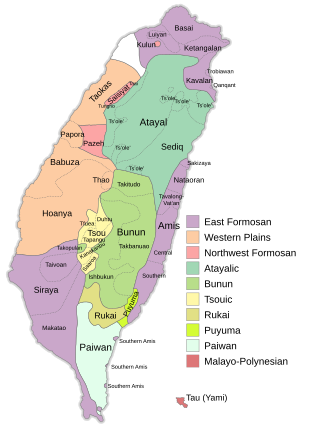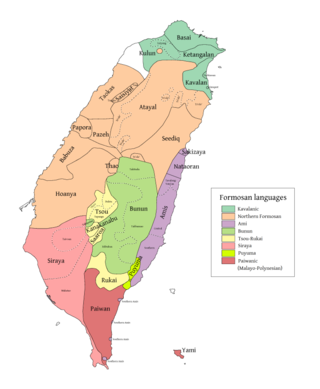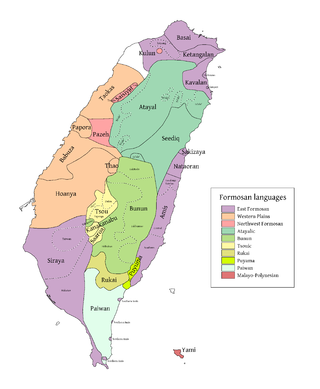
The Austronesian languages are a language family widely spoken throughout Maritime Southeast Asia, parts of Mainland Southeast Asia, Madagascar, the islands of the Pacific Ocean and Taiwan. They are spoken by about 328 million people. This makes it the fifth-largest language family by number of speakers. Major Austronesian languages include Malay, Javanese, Sundanese, Tagalog, Malagasy and Cebuano. According to some estimates, the family contains 1,257 languages, which is the second most of any language family.

The Formosan languages are a geographic grouping comprising the languages of the indigenous peoples of Taiwan, all of which are Austronesian. They do not form a single subfamily of Austronesian but rather up to nine separate primary subfamilies. The Taiwanese indigenous peoples recognized by the government are about 2.3% of the island's population. However, only 35% speak their ancestral language, due to centuries of language shift. Of the approximately 26 languages of the Taiwanese indigenous peoples, at least ten are extinct, another four are moribund, and all others are to some degree endangered. They are national languages of Taiwan.

Basay was a Formosan language spoken around modern-day Taipei in northern Taiwan by the Basay, Qauqaut, and Trobiawan peoples. Trobiawan, Linaw, and Qauqaut were other dialects.

The Siraya people are a Taiwanese indigenous people. The Siraya settled flat coastal plains in the southwest part of the island of Taiwan and corresponding sections of the east coast; the area is identified today with Tainan City and Taitung County. At least four communities make up the group: Mattauw, Soelangh, Baccloangh, and Sinckan. The first four communities correspond to the modern-day districts of Madou, Jiali, Shanhua, and Sinshih, respectively.

Kavalan was formerly spoken in the Northeast coast area of Taiwan by the Kavalan people (噶瑪蘭). It is an East Formosan language of the Austronesian family.

The Qauqaut were a Taiwanese Indigenous people who lived primarily in the town of Su-ao in Yilan County. They spoke the Basay language, which is a Kavalanic language, an Austronesian language family of Taiwan. According to Japanese anthropologist Inō Kanori, the Qauqaut people had been assimilated by the Kavalan people by early 20th century. The Qauqaut people are not recognised by the government of Taiwan.
Proto-Austronesian is a proto-language. It is the reconstructed ancestor of the Austronesian languages, one of the world's major language families. Proto-Austronesian is assumed to have begun to diversify c. 4000 BCE – c. 3500 BCE in Taiwan.

Robert A. Blust was an American linguist who worked in several areas, including historical linguistics, lexicography and ethnology. He was Professor of Linguistics at the University of Hawaiʻi at Mānoa. Blust specialized in the Austronesian languages and made major contributions to the field of Austronesian linguistics.

Siraya is a Formosan language spoken until the end of the 19th century by the indigenous Siraya people of Taiwan, derived from Proto-Siraya. Some scholars believe Taivoan and Makatao are two dialects of Siraya, but now more evidence shows that they should be classified as separate languages.

The Tsouic languages are three Formosan languages, Tsou proper and the Southern languages Kanakanavu and Saaroa. The Southern Tsouic languages of Kanakanavu and Saaroa have the smallest phonemic inventories out of all the Formosan languages, with each language having only 13 consonants and 4 vowels. These two languages are highly endangered, as many Southern Tsouic speakers are shifting to Bunun and Mandarin Chinese.

The East Formosan languages consist of various Formosan languages scattered across Taiwan, including Kavalan, Amis, and the extinct Siraya language. This grouping is supported by both Robert Blust and Paul Jen-kuei Li. Li considers the Siraya-speaking area in the southwestern plains of Taiwan to be the most likely homeland of the East Formosan speakers, where they then spread to the eastern coast of Taiwan and gradually migrated to the area of modern-day Taipei.
This article describes the personal pronoun systems of various Austronesian languages.

Luilang, or ambiguously Ketagalan, was a Formosan language spoken south of modern-day Taipei in northern Taiwan by one of several peoples that have been called Ketagalan. The language probably went extinct in the mid-20th century and it is very poorly attested.

Taivoan or Taivuan, is a Formosan language spoken until the end of the 19th century by the indigenous Taivoan people of Taiwan. Taivoan used to be regarded as a dialect of Siraya, but now more evidence has shown that they should be classified as separate languages. The corpora previously regarded as Siraya like the Gospel of St. Matthew and the Notes on Formulary of Christianity translated into "Siraya" by the Dutch people in the 17th century should be in Taivoan majorly.

Plains indigenous peoples, also known as Pingpu people and previously as plain aborigines, are Taiwanese indigenous peoples originally residing in lowland regions, as opposed to Highland indigenous peoples. Plains indigenous peoples consist of anywhere from eight to twelve individual groups, or tribes, rather than being a single ethnic group. They are part of the Austronesian family. Beginning in the 17th century, plains indigenous peoples have been heavily influenced by external forces from Dutch, Spanish, and Han Chinese colonization of Taiwan. This ethnic group has since been extensively assimilated with Han Chinese language and culture; they have lost their cultural identity, and it is almost impossible without careful inspection to distinguish plains indigenous peoples from Taiwanese Han people.

The Taivoan or Tevorangh are a Taiwanese indigenous people. The Taivoan originally settled around hill and basin areas in Tainan, especially in the Yujing Basin, which the Taivoan called Tamani, later transliterated into Japanese Tamai (玉井) and later borrowed in Chinese (Yujing). The Taivoan historically called themselves Taivoan, Taibowan, Taiburan or Shisha.

The Makatao people, also written Makatau or Makattau, are an indigenous people in Taiwan. The Makatao originally settled around lowland Kaohsiung in Southern Taiwan, later largely migrating to Pingtung and even further to Taitung in the early 19th century due to the influx of Chinese immigrants.

Dazhuang is a community located in Tungli Village, Fuli Township in Hualien County, Taiwan. Dazhuang used to be an old community of Amis, until 1845 when some plain indigenous people started to migrate from Southern Taiwan to here. It was the most populous community in Fuli between Qin dynasty and Japanese occupation period, and so called the name Tuā-tsng, which means "a big village" in Taiwanese.

Guanshan Village, also called by the locals as Alikuan or Aliguan, is an indigenous Taivoan community located in Jiaxian District in Kaohsiung City, Taiwan. As driven by Chinese immigrants and Siraya, Taivoan people started to emigrate from Tainan to Kaohsiung in the early 18th century, and eventually founded the community in 1744. Alikuan was also an important battle field in Tapani incident in 1915.

A Kong-kài, literally "the Public Hall" in Taiwanese Hokkien, is a temple or shrine where indigenous peoples like the Siraya, Taivoan or Makatao hold rituals for their ancestral spirits. Historical records indicate that in the past, the Kong-kài served other functions, including a men's gathering place or a public meeting place for discussions and decision-making.














